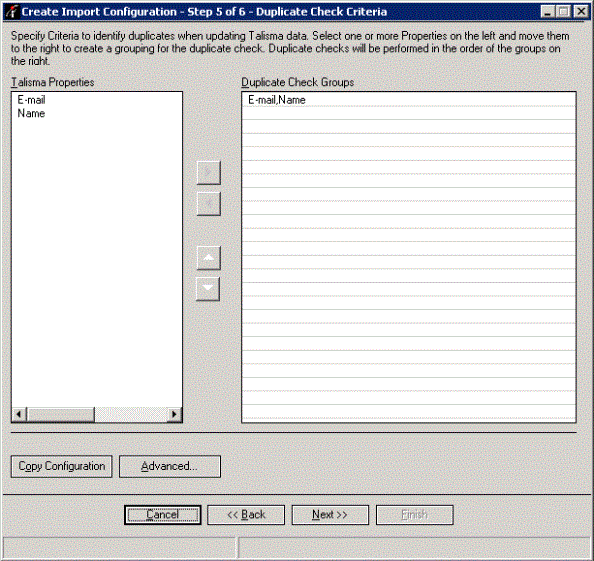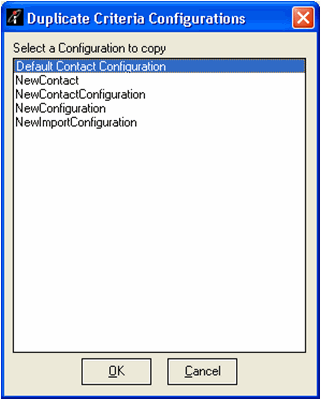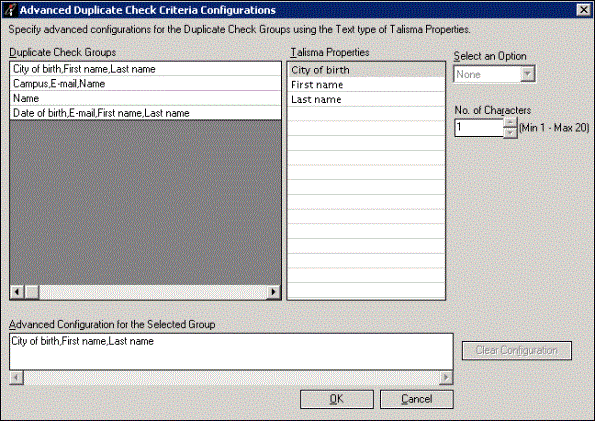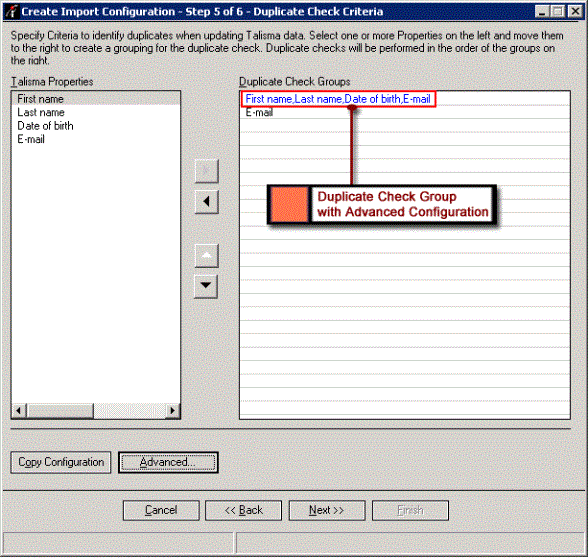Step 5 - Specifying Duplicate Check Criteria
About Duplicate Check
While importing data into Talisma, it is necessary to check whether an Object item containing the same information already exists in the system. The Duplicate Check criteria in the Talisma Data Management Utility comprise Properties or Property groups of the base Object that have been mapped in the Mapping page of the wizard.
The value of the specified Object Property is compared with the value available in the external data source. If the same value is found in an external record, the record is not imported, or the value of the Object item in Talisma will be updated depending on the mode of the data import. You can specify more than one Talisma Property or Property group to be used as the duplicate check criteria. Subsequent duplicate check criteria are used only if previous criteria do not yield a match. You can modify the order in which the duplicate check must be performed.
Example
You want to import an external record containing the following information: Name: John, E-mail Address: john@worldwaves.com.
A Contact with the name John, and the e-mail address, john@talisma.com exists in Talisma.
While importing information into Talisma, you specify the following duplicate check criteria:
• Name
• E-mail, Name
Note that this is a group of Properties. The duplicate check will be performed for E-mail and Name.
The external record will be successfully imported as no matching e-mail address was found. As a result, a Contact with the name John, and the e-mail address, john@worldwaves.com will be created in Talisma.
About Advanced Duplicate Check
You can configure Advanced Duplicate Check Criteria on the Duplicate Check Groups configured in the Duplicate Check Criteria page, where the base Objects of the Import Configuration are Contact and Lead. To create Advanced Duplicate Check Criteria, the Use Advanced Duplicate Check Criteria global option must be set to Yes in Talisma Business Administrator and a Duplicate check Group must be configured in the Duplicate Check Criteria page.
When the Use Advanced Duplicate Check Criteria global option is set to Yes and Advanced Duplicate Check Criteria are configured, the Contact and Lead information that are imported to Talisma are resolved using the Advanced Duplicate Check Criteria.
Example
The following example describes how the Advanced Duplicate Check Criteria can be used to import unique Contact records in Talisma.
• For the Contact Object, the following Duplicate Check Group is configured in the Duplicate Check Criteria page:
◦ Date of birth,First name,Last name
• The Advanced Duplicate Check Criteria are configured on the Date of birth,First name, Last name Duplicate Check Group as follows:
◦ First 3 Characters of First name
◦ First 4 Characters of Last name
• The CheckForDuplicatesInStagingTable option is set to 1 in the Talisma Global Config Utility.
Following data is used for the import operation:
|
First name |
Last name |
Date of Birth |
Program |
|
Rob |
Wilbur |
01-01-1990 |
Arts |
|
Robby |
Wills |
01-01-1990 |
Science |
|
Robin |
Williams |
01-01-1990 |
Commerce |
|
R |
Wills |
01-01-1990 |
Commerce |
When the Import Configuration is run in the Import New Data mode, the Advanced Duplicate Check Criteria created for the Contact Object is used to check for duplicate Contact records in the interface table and resolve the Contact.
• When the first record is imported in Talisma, a Contact is created assuming that there are no matching Contacts available in Talisma.
• The second and third records are duplicates as the first three characters of the first name and the first four characters of the last name of the second record match with the first three characters of the first name and the first four characters of the last name of the third record. Therefore, these two records will not be imported.
• When the fourth record is imported in Talisma, the First name has only one character. The Advanced Duplicate Check Criteria performs an exact match of the first three characters and it does not find a matching Contact. Therefore a Contact is created.
The following Contacts will be created in Talisma:
|
First name |
Last name |
Date of Birth |
Program |
|
Rob |
Wilbur |
01-01-1990 |
Arts |
|
R |
Wills |
01-01-1990 |
Commerce |
|
Note If the CheckForDuplicatesInStagingTable option is set to 0 in the Talisma Global Config Utility, duplicate records will be imported to Talisma. For information on the CheckForDuplicatesInStagingTable option, see Business Administrator Help. |
To Specify Duplicate Check Criteria
1. When you click Next in Step 4 of 6, the Create Import Configuration – Step 5 of 6 - Duplicate Check Criteria page is displayed. In this page, you must specify the criteria to be used for checking duplicate records.

Selecting Duplicate Criteria Properties
2. Select a Property from the Talisma Properties area, and click 
- OR -
To specify a Property group, select a Property, hold down the CTRL key, and select other Properties. Click 
To set the order of the duplicate check criteria, click 

3. Click the Advanced button to configure Advanced Duplicate Check Criteria.
|
Note The Advanced button is available for selection when: • The Use Advanced Duplicate Check Criteria global option is set to Yes in Talisma Business Administrator. • A Property is listed in the Duplicate Check Groups area. For information about the Use Advanced Duplicate Check Criteria global option, see Talisma Business Administrator Help. |
For more information on configuring Advanced Duplicate Check Criteria, see “To Configure Advanced Duplicate Check Criteria”.
4. Click the Copy Configuration button.
Existing Duplicate Configurations configured in the Duplicate Criteria Manager are displayed in the Duplicate Criteria Configurations dialog box.

The Duplicate Criteria Configurations Dialog Box
The Copy Configuration button is displayed only if you are performing an Import operation specific to the Contact or Lead Objects.
This dialog box lists Duplicate Configurations that were created for the Contact or Lead Objects if Contact or Lead records are being imported.
Select the Duplicate Configuration that you want to copy and click OK. The Duplicate Criteria Configurations dialog box is closed.
|
Note • When you select a Duplicate Configuration, the duplicate check is performed based on the copied Duplicate Configuration. Duplicate check criteria that you configured in the Duplicate Criteria Manager are not considered for performing a duplicate check. • When a Duplicate Criteria Configuration is deleted from the Duplicate Criteria Manager, it will no longer be available for selection in the Import wizard when the User creates or edits an Import Configuration. Talisma does not prevent a User from deleting a Duplicate Criteria Configuration that is copied and used in an Import operation. When the same Import Configuration is run later, the deleted Duplicate Criteria Configuration will continue to be implicitly available in the Import Configuration. However, it will not be displayed in the Duplicate Criteria Configurations dialog box. • When a Duplicate Configuration is copied, the Advanced Duplicate Check Criteria configured for the Duplicate Configuration are also copied. |
If the base Object is not related to any other Object, the Create Import Configuration – page 6 of 6 page is displayed.
- OR -
If the base Object is related to another Object, the Talisma Related Object Mapping page is displayed.
a. Select the related Object for which you want to import data. You can import data of only one related Object at a time.
b. Specify the mappings for the Properties of the related Object, and click Next.
c. Specify the Duplicate Check criteria for the related Object, and click Next.
The Reference Mapping page is displayed.
|
Note • You cannot use the Subject Property as a Duplicate Check condition. • While importing Relationships for custom Objects in the Import New Data mode, it is mandatory to specify Duplicate Check criteria for the base Object and related Object. |
To Configure Advanced Duplicate Check Criteria
|
Caution If Advanced Duplicate Check Criteria are configured, it will take longer to resolve a Contact and a Lead in Talisma. This can affect the performance while working with Talisma. |
1. Perform steps 1 through 3 of “To Specify Duplicate Check Criteria”.
The Advanced Duplicate Check Criteria Configurations dialog box is displayed.

The Advanced Duplicate Check Criteria Configurations Dialog Box
2. Select a Duplicate Check Group in the Duplicate Check Groups area.
3. Select a Property in the Talisma Properties area.
|
Note • Only Text type of Properties are listed in the Talisma Properties area. • By default, the first Property is selected. |
4. Select First from the Select an Option list.
By default, None is selected and is disabled. The Select an Option list is enabled when a Property is selected in the Talisma Properties area.
5. Select a number in the No. of Characters field.
You can specify a value ranging from 1 to 20 in this field. Additionally, the selected value is applicable only to Desktop Client. It does not apply to Web Client.
When None is selected in the Select an Option list, the No. of Characters field cannot be edited.
6. Repeat steps 3 through 5 to configure Advanced Configuration for additional Properties.
The Advanced Configuration for the Selected Group field displays the Advanced Duplicate Check Criteria configured for the selected Duplicate Check Group.
|
Note By default, the Advanced Configuration for the Selected Group field displays comma separated Text type of Talisma Properties that are configured in the selected Duplicate Check Group. For example, if the selected Duplicate Check Group is E-mail,First name,Last name, the Advanced Configuration for the Selected Group field will display: E-mail,First name,Last name |
|
Example You have configured a Duplicate Check Group with the following Test type of Contact Properties: • First name • Last name In the Advanced Duplicate Check Criteria Configurations dialog box, you have configured the following settings for the three Properties: Configurations for the First name Property: • In the Select an Option list, First is selected. • In the No. of Characters field 3 is selected. Configurations for the Last name Property: • In the Select an Option list, First is selected. • In the No. of Characters field 2 is selected. Configurations for the E-mail Property: • In the Select an Option list, None is selected. • The No. of Characters field is disabled. The Advanced Duplicate Check Criteria configured for the three Properties belonging to the Duplicate Check Group will be displayed in the Advanced Configuration for the Selected Group field as follows:
|
7. Click OK to save the Advanced Duplicate Check Criteria.
- OR -
Click the Cancel button to ignore the changes done in the Advanced Duplicate Check Criteria Configuration dialog box.
- OR -
Click the Clear Configuration button to remove the Advanced Duplicate Check Criteria configured for Talisma Properties. The Advanced Configuration for the Selected Group field will display the default value.
By default, the Clear Configuration button is disabled. It becomes available for selection when First is selected in the Select an Option list.
The Duplicate Check Group(s) for which the Advanced Configuration is set appears blue as depicted in the following graphic:

Talisma Properties that are Configured with Advanced Configuration
|
Note When Advanced Duplicate Check Criteria are configured for Talisma Properties and later the Use Advanced Duplicate Check Criteria global option is set to No in Talisma Business Administrator, the Properties will be disabled. However, the Advanced Duplicate Check Criteria will still be used to create unique Contacts through an import operation. To prevent the use of Advanced Duplicate Check Criteria, you must clear the Advanced Configuration. |
8. Click Next.
The Advanced Duplicate Check Criteria Configurations are saved.
If you click the Cancel button, the Advanced Configurations for the Duplicate Check Group(s) specified in the Advanced Duplicate Check Criteria Configurations dialog box are not saved.
